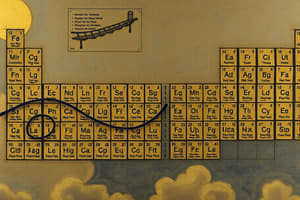Podcast
Questions and Answers
Which of the following statements accurately describes the relationship between valence electrons and the group number for main group elements?
Which of the following statements accurately describes the relationship between valence electrons and the group number for main group elements?
- The group number is equal to half the number of valence electrons.
- The group number bears no direct relation to the number of valence electrons.
- The group number is typically double the number of valence electrons.
- The group number is equal to the number of valence electrons. (correct)
An element has the electron configuration of $ns^2np^4$ in its valence shell. According to the provided information, to which group does this element belong?
An element has the electron configuration of $ns^2np^4$ in its valence shell. According to the provided information, to which group does this element belong?
- Group 4
- Group 6
- Group 14
- Group 16 (correct)
How many electrons can each box in an orbital diagram hold?
How many electrons can each box in an orbital diagram hold?
- 1
- Depends on the orbital type
- 3
- 2 (correct)
What determines the number of boxes in an elements orbital?
What determines the number of boxes in an elements orbital?
What is the maximum number of dots that can be represented in the Lewis structure of an atom?
What is the maximum number of dots that can be represented in the Lewis structure of an atom?
Which rule dictates that electrons are added individually to each orbital within a subshell before any orbital is doubly occupied?
Which rule dictates that electrons are added individually to each orbital within a subshell before any orbital is doubly occupied?
Which of the following best explains why noble gases are the least reactive?
Which of the following best explains why noble gases are the least reactive?
According to the provided diagrams, which quantum number has the greatest effect in visualizing orbitals and electrons of an atom?
According to the provided diagrams, which quantum number has the greatest effect in visualizing orbitals and electrons of an atom?
How are elements arranged in the periodic table?
How are elements arranged in the periodic table?
Which characteristic do elements within the same group (column) of the periodic table share?
Which characteristic do elements within the same group (column) of the periodic table share?
Flashcards
Orbital Diagrams
Orbital Diagrams
Visualizes orbitals and electrons of an atom using boxes; each box holds a max of two electrons. The number of boxes depends on quantum number (ml).
Valence Electrons
Valence Electrons
Electrons in the outermost shell of an atom.
Periodic Blocks
Periodic Blocks
Type of element block determined by the orbital type of valence electrons (s, p, d, f).
Valence Electrons and Group Number
Valence Electrons and Group Number
Signup and view all the flashcards
Lewis Structure
Lewis Structure
Signup and view all the flashcards
Octet Rule in Lewis Structures
Octet Rule in Lewis Structures
Signup and view all the flashcards
Hund's Rule
Hund's Rule
Signup and view all the flashcards
Periods vs Groups
Periods vs Groups
Signup and view all the flashcards
Element Arrangement
Element Arrangement
Signup and view all the flashcards
Study Notes
- Electrons fill orbitals with one electron first, aligning parallel, before pairing up.
Orbital Diagrams
- They are a visual representation of an atom's orbitals and electrons using boxes.
- Each box can hold a maximum of two electrons.
- The number of boxes depends on the magnetic quantum number (ml).
- These diagrams are based on three principles.
Lewis Structure of Atoms
- It is a visual representation of valence electrons using dots.
- Atoms can have a maximum of eight dots due to the maximum of eight valence electrons.
- Filling order follows Hund's Rule, with one electron added to each orbital before pairing occurs.
Valence Electrons & Periodic Blocks
- Divisions in the periodic table are based on the orbital type of valence electrons.
- Valence electrons are in the outermost shell of an atom.
- The group number corresponds to the number of valence electrons.
- Transition metals typically have varying valences.
- Noble gases are the least reactive because they have complete outer shells.
Periodic Table Features
- The layout arranges all known elements into periods (rows) and groups (columns).
- Elements in the same group share similar chemical properties.
- Elements are arranged according to their atomic number and electron configurations.
Studying That Suits You
Use AI to generate personalized quizzes and flashcards to suit your learning preferences.
Description
Learn about filling orbitals with electrons one at a time before pairing, aligning parallel. Explore orbital diagrams, Lewis structures, and the significance of valence electrons in determining an atom's chemical properties and reactivity. Understand the relationship between the periodic table blocks and valence electrons.




